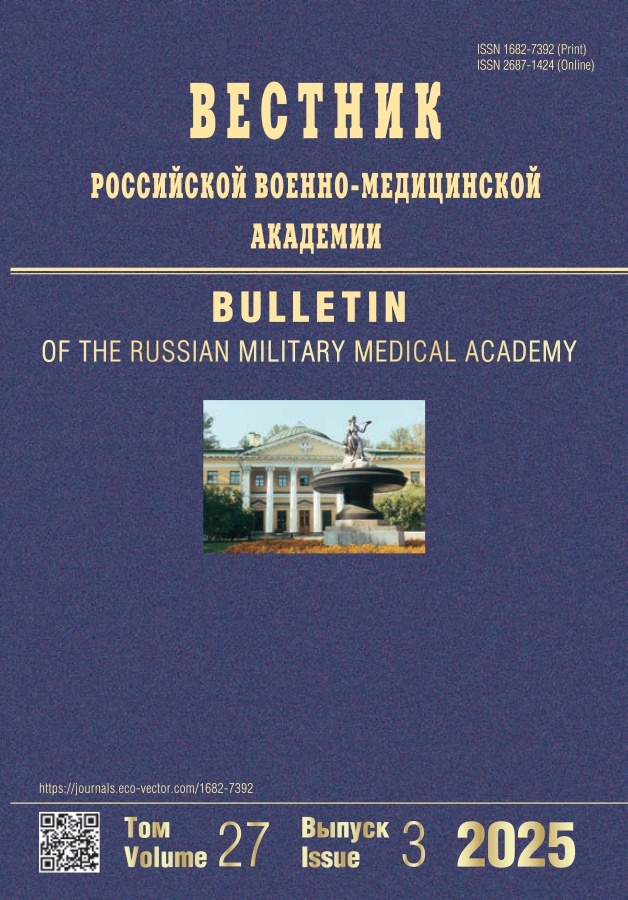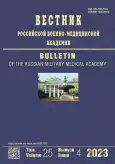Эффективность протокола фокусированного ультразвукового обследования раненых и пострадавших при боевой хирургической травме
- Авторы: Лахин Р.Е.1, Кусай А.С.1, Усольцев Е.А.2, Касимов Р.Р.1,2, Цыганков К.А.1, Цветков В.Г.1, Шустров В.В.1, Фадеев С.В.3
-
Учреждения:
- Военно-медицинская академия имени С. М. Кирова
- 442-й Военный клинический госпиталь
- 1586-й Военный клинический госпиталь (филиал № 3)
- Выпуск: Том 25, № 4 (2023)
- Страницы: 603-610
- Раздел: Оригинальное исследование
- URL: https://journal-vniispk.ru/1682-7392/article/view/253752
- DOI: https://doi.org/10.17816/brmma568876
- ID: 253752
Цитировать
Аннотация
Оказание медицинской помощи в вооруженных конфликтах имеет ряд особенностей. Одной из доступных и информативных методик диагностики у раненых и пострадавших в условиях ограниченного ресурса материально-технической базы является ультразвуковое исследование. Определена чувствительность и специфичность диагностики свободной жидкости в брюшной полости и пневмоторакса при применении расширенного протокола фокусированной ультразвуковой оценки у раненых при боевой травме на этапе квалифицированной хирургической помощи. Выполнено ретроспективное когортное исследование медицинских данных 85 пострадавших и раненых в грудь и живот с целью выявления объема повреждения. Для этого использовали фокусированное ультразвуковое обследование с помощью расширенного протокола фокусированной ультразвуковой оценки у раненых при боевой травме. Данный протокол применяли ко всем пострадавшим с ранениями груди и живота с целью выявления объема повреждения. Выявлено, что чувствительность расширенного протокола фокусированной ультразвуковой оценки у раненых при боевой травме для диагностики свободной жидкости в брюшной полости составила 100 %, специфичность — 66 %. Чувствительность расширенного протокола фокусированной ультразвуковой оценки у раненых при боевой травме для диагностики пневмоторакса составила 87 %, специфичность — 8 %. Полученные результаты подтвердили необходимость использования расширенного протокола фокусированной ультразвуковой оценки у раненых при боевой травме для принятия решения хирургической тактики пострадавшему в условиях недоступности других методик диагностики, в частности во время вооруженных конфликтов при массовом поступлении раненых и пострадавших. Кроме того, использование анестезиологами или врачами-хирургами расширенного протокола фокусированной ультразвуковой оценки у раненых при боевой травме является важным подспорьем, хотя для принятия решения о выполнении операции требуется командная работа.
Полный текст
Открыть статью на сайте журналаОб авторах
Роман Евгеньевич Лахин
Военно-медицинская академия имени С. М. Кирова
Email: doctor-lahin@yandex.ru
ORCID iD: 0000-0001-6819-9691
SPIN-код: 7261-9985
доктор медицинских наук
Россия, Санкт-ПетербургАлександр Сергеевич Кусай
Военно-медицинская академия имени С. М. Кирова
Email: doctorcygankov@mail.ru
ORCID iD: 0000-0002-0668-9676
SPIN-код: 8843-5840
начальник отделения
Россия, Санкт-ПетербургЕвгений Александрович Усольцев
442-й Военный клинический госпиталь
Email: doctorcygankov@mail.ru
ORCID iD: 0000-0001-6497-1429
SPIN-код: 3460-8662
анестезиолог-реаниматолог
Россия, Санкт-ПетербургРустам Рифкатович Касимов
Военно-медицинская академия имени С. М. Кирова; 442-й Военный клинический госпиталь
Email: rusdoc77@mail.ru
ORCID iD: 0000-0001-5866-8378
SPIN-код: 5682-2810
кандидат медицинских наук
Россия, Санкт-Петербург; Санкт-ПетербургКирилл Алексеевич Цыганков
Военно-медицинская академия имени С. М. Кирова
Автор, ответственный за переписку.
Email: doctorcygankov@mail.ru
ORCID iD: 0000-0002-2357-0685
SPIN-код: 7133-0503
кандидат медицинских наук
Россия, Санкт-ПетербургВасилий Геннадьевич Цветков
Военно-медицинская академия имени С. М. Кирова
Email: vasilii_cvetkov@mail.ru
ORCID iD: 0000-0003-4980-597X
SPIN-код: 5316-4617
Scopus Author ID: 1119527
старший ординатор
Россия, Санкт-ПетербургВячеслав Владимирович Шустров
Военно-медицинская академия имени С. М. Кирова
Email: shustrov@anesthvmeda.ru
ORCID iD: 0000-0001-5144-3360
SPIN-код: 5955-7492
преподаватель кафедры
Россия, Санкт-ПетербургСергей Владимирович Фадеев
1586-й Военный клинический госпиталь (филиал № 3)
Email: doctorcygankov@mail.ru
ORCID iD: 0009-0002-6122-4772
SPIN-код: 1043-7366
начальник хирургического отделения
Россия, Наро-ФоминскСписок литературы
- Гайдук С.В., Овчинников Ю.В., Халимов Ю.Ш., Гайдук В.А. Кардиореспираторная патология у раненых контртеррористической операции в Чеченской Республике // Вестник Российской военно-медицинской академии. 2016. № 1(53). С. 22–28.
- Полушин Ю.С. Анестезиологическая и реаниматологическая помощь раненым на войне. Санкт-Петербург: ЭЛБИ, 2003. 288 c.
- Тришкин Д.В., Крюков Е.В., Чуприна А.П. Методические рекомендации по лечению боевой хирургической травмы. Москва: ГВМУ МО РФ, 2022. 373 с.
- Жирнова Е.А., Лахин Р.Е., Щеголев А.В., Грачев И.Н. Сравнение ультразвуковых протоколов для диагностики поражения при пневмонии // Вестник Российской военно-медицинской академии. 2019. № 4(68). С. 28–34.
- Лахин Р.Е., Жирнова Е. А., Щеголев А.В., и др. Специфичность и чувствительность ультразвукового исследования легких у пациентов с пневмонией, вызванной COVID-19 // Вестник анестезиологии и реаниматологии. 2022. Т. 19, № 3. С. 7–14. doi: 10.21292/2078-5658-2022-19-3-7-14
- Bockler D., Hatzl J., Bischoff M.S., et al. Intra-abdominal vascular injuries after blunt abdominal trauma // Chirurgie (Heidelb). 2023. Vol. 94, No. 8. P. 696–702. doi: 10.1007/s00104-023-01931-9
- Bradley C.A., Hollon M.M. Ultrasound rounds: anesthesiologist-performed intraoperative point-of-care focused assessment with sonography in trauma examination changes surgical managemen // A A Pract. 2023. Vol. 17, No. 8. Р. e01707. doi: 10.1213/XAA.0000000000001707
- Devadoss H., Sharma P., Nair V.V., et al. Diagnostic accuracy of e-FAST in stable blunt trauma chest: a prospective analysis of 110 cases at a Tertiary care center // Indian J Crit Care Med. 2021. Vol. 25, No. 10. Р. 1167–1172. doi: 10.5005/jp-journals-10071-23995
- Netherton S., Milenkovic V., Taylor M., Davis P.J. Diagnostic accuracy of eFAST in the trauma patient: a systematic review and meta-analysis // CJEM. 2019. Vol. 21, No. 6. Р. 727–738. doi: 10.1017/cem.2019.381
- Brun P.M., Bessereau J., Chenaitia H. Stay and play eFAST or scoop and run eFAST? That is the question! // Am J Emerg Med. 2014. Vol. 32, No. 2. Р. 166–170. doi: 10.1016/j.ajem.2013.11.008
- Nunes L.W., Simmons S., Hallowell M.J., et al. Diagnostic performance of trauma US in identifying abdominal or pelvic free fluid and serious abdominal or pelvic injury // Acad Radiol. 2001. Vol. 8, No. 2. Р. 128–136. doi: 10.1016/s1076-6332(01)90057-1
- Jonathan D.M., Perreault M.D. Impact of a 4-hour introductory eFAST training intervention among ultrasound-naïve U.S. military medics // Mil Med. 2020. Vol. 185, No. 5–6. Р. e601–e608. doi: 10.1093/milmed/usaa014
- LaDuke M., Monti J., Cronin A., Gillum B. Ultrasound detection of soft tissue abscesses performed by non-physician U.S. Army Medical Providers Naïve to Diagnostic Sonography // Mil Med. 2017. Vol. 182, No. 3. Р. e1825–e1830. doi: 10.7205/MILMED-D-16-00306
- Лахин Р.Е. Ультразвук в анестезиологии и реаниматологии. Чему учить? // Анестезиология и реаниматология. 2016. Т. 61, № 4. С. 263–265. doi: 10.18821/0201-7563-2016-61-4-263-265
- Monti J.D., Younggren B., Blankenship R. Ultrasound detection of pneumothorax with minimally trained sonographers: a preliminary study // J Spec Oper Med. 2009. Vol. 9, No. 1. Р. 43–46. doi: 10.55460/9GWU-MQO4
Дополнительные файлы









